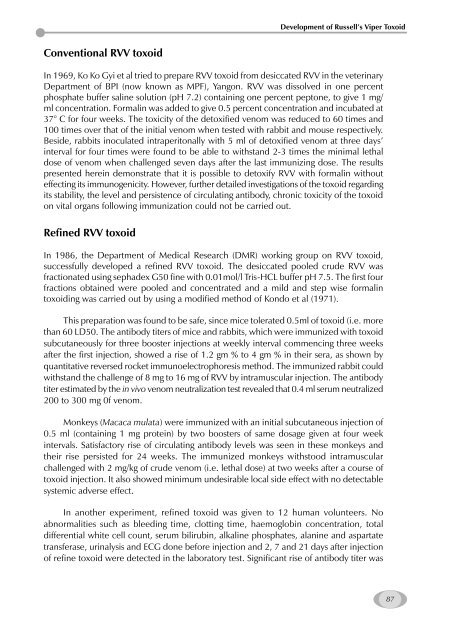Management of Snakebite and Research Management of Snakebite ...
Management of Snakebite and Research Management of Snakebite ...
Management of Snakebite and Research Management of Snakebite ...
Create successful ePaper yourself
Turn your PDF publications into a flip-book with our unique Google optimized e-Paper software.
Conventional RVV toxoid<br />
In 1969, Ko Ko Gyi et al tried to prepare RVV toxoid from desiccated RVV in the veterinary<br />
Department <strong>of</strong> BPI (now known as MPF), Yangon. RVV was dissolved in one percent<br />
phosphate buffer saline solution (pH 7.2) containing one percent peptone, to give 1 mg/<br />
ml concentration. Formalin was added to give 0.5 percent concentration <strong>and</strong> incubated at<br />
37° C for four weeks. The toxicity <strong>of</strong> the detoxified venom was reduced to 60 times <strong>and</strong><br />
100 times over that <strong>of</strong> the initial venom when tested with rabbit <strong>and</strong> mouse respectively.<br />
Beside, rabbits inoculated intraperitonally with 5 ml <strong>of</strong> detoxified venom at three days’<br />
interval for four times were found to be able to withst<strong>and</strong> 2-3 times the minimal lethal<br />
dose <strong>of</strong> venom when challenged seven days after the last immunizing dose. The results<br />
presented herein demonstrate that it is possible to detoxify RVV with formalin without<br />
effecting its immunogenicity. However, further detailed investigations <strong>of</strong> the toxoid regarding<br />
its stability, the level <strong>and</strong> persistence <strong>of</strong> circulating antibody, chronic toxicity <strong>of</strong> the toxoid<br />
on vital organs following immunization could not be carried out.<br />
Refined RVV toxoid<br />
Development <strong>of</strong> Russell’s Viper Toxoid<br />
In 1986, the Department <strong>of</strong> Medical <strong>Research</strong> (DMR) working group on RVV toxoid,<br />
successfully developed a refined RVV toxoid. The desiccated pooled crude RVV was<br />
fractionated using sephadex G50 fine with 0.01mol/l Tris-HCL buffer pH 7.5. The first four<br />
fractions obtained were pooled <strong>and</strong> concentrated <strong>and</strong> a mild <strong>and</strong> step wise formalin<br />
toxoiding was carried out by using a modified method <strong>of</strong> Kondo et al (1971).<br />
This preparation was found to be safe, since mice tolerated 0.5ml <strong>of</strong> toxoid (i.e. more<br />
than 60 LD50. The antibody titers <strong>of</strong> mice <strong>and</strong> rabbits, which were immunized with toxoid<br />
subcutaneously for three booster injections at weekly interval commencing three weeks<br />
after the first injection, showed a rise <strong>of</strong> 1.2 gm % to 4 gm % in their sera, as shown by<br />
quantitative reversed rocket immunoelectrophoresis method. The immunized rabbit could<br />
withst<strong>and</strong> the challenge <strong>of</strong> 8 mg to 16 mg <strong>of</strong> RVV by intramuscular injection. The antibody<br />
titer estimated by the in vivo venom neutralization test revealed that 0.4 ml serum neutralized<br />
200 to 300 mg 0f venom.<br />
Monkeys (Macaca mulata) were immunized with an initial subcutaneous injection <strong>of</strong><br />
0.5 ml (containing 1 mg protein) by two boosters <strong>of</strong> same dosage given at four week<br />
intervals. Satisfactory rise <strong>of</strong> circulating antibody levels was seen in these monkeys <strong>and</strong><br />
their rise persisted for 24 weeks. The immunized monkeys withstood intramuscular<br />
challenged with 2 mg/kg <strong>of</strong> crude venom (i.e. lethal dose) at two weeks after a course <strong>of</strong><br />
toxoid injection. It also showed minimum undesirable local side effect with no detectable<br />
systemic adverse effect.<br />
In another experiment, refined toxoid was given to 12 human volunteers. No<br />
abnormalities such as bleeding time, clotting time, haemoglobin concentration, total<br />
differential white cell count, serum bilirubin, alkaline phosphates, alanine <strong>and</strong> aspartate<br />
transferase, urinalysis <strong>and</strong> ECG done before injection <strong>and</strong> 2, 7 <strong>and</strong> 21 days after injection<br />
<strong>of</strong> refine toxoid were detected in the laboratory test. Significant rise <strong>of</strong> antibody titer was<br />
87









